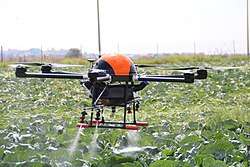Agricultural drone

An agricultural drone is an unmanned aerial vehicle applied to farming in order to help increase crop production and monitor crop growth. Through the use of advanced sensors and digital imaging capabilities, farmers are able to use these drones to help them gather a richer picture of their fields. Information gathered from such equipment may prove useful in improving crop yields and farm efficiency.
Agricultural drones let farmers see their fields from the sky. This bird's-eye view can reveal many issues such as irrigation problems, soil variation, and pest and fungal infestations. Multispectral images show a near-infrared view as well as a visual spectrum view. The combination shows the farmer the differences between healthy and unhealthy plants, a difference not always clearly visible to the naked eye. Thus, these views can assist in assessing crop growth and production.
Additionally, the drone can survey the crops for the farmer periodically to their liking. Weekly, daily, or even hourly, pictures can show the changes in the crops over time, thus showing possible “trouble spots”. Having identified these trouble spots, the farmer can attempt to improve crop management and production.
Legality
As drones entered use in agriculture, the Federal Aviation Administration (FAA) encouraged farmers to use this new technology to monitor their fields. However, with the unexpected boom of agricultural drones, the FAA quickly retracted such encouragement, pending new rules and regulations. With incidents such as drones crashing into crop dusters, it was vital for the FAA and the AFBF (American Farm Bureau Federation) to agree on regulations that would allow the beneficial use of such drones in a safe and efficient manner. Although the American Farm Bureau Federation would like small adjustments to some of the restrictions that have been implemented, they are happy that the agricultural industry can actually use this new machinery without the worry of facing any legal issues.
Security and ethics
While there are many ways to improve crop growth through the use of agricultural drones, there is also a question of security. Farmers can use drones to monitor and record their crop, but what if an another company started flying their drones in unregulated areas to survey their competition? Such a scenario could lead to compromising vital company secrets. People want to know that they are safe and protected, so the burden doesn’t just fall on the farmer, but on many of those around the farmer, too.
The use of agricultural drones has ethical and social implications. One benefit is that they are able to monitor and control the use of pesticides properly. This allows minimizing the environmental impact of pesticides. However, drones don't need access authority to flying overs someone's property at under 400 feet (130 m) altitude. They may have microphones and cameras attached, and the resulting concern for potential privacy violation has caused some opposition towards drones.
Future use
There is a lot of room for growth with agricultural drones. With technology constantly improving, imaging of the crops will need to improve as well. With the data that drones record from the crops the farmers are able to analyze their crops and make educated decisions on how to proceed given the accurate crop information. Software programs for analyzing and correcting crop production have the potential to grow in this market. Close your eyes and imagine a farmer being able to fly a drone over their crops, be able to accurately identify an issue in a specific area, and then take the necessary actions in order to resolve the problem. Having this capability allows the farmer to, in turn, have more time to focus on the big picture of production instead of spending time surveying their crops. The drones allow for real time data to be delivered back to the user to be inspected, which for a farmer, is a huge game changer.
See also
References
- Reference page: Anderson, C. (2014, May). Agricultural drones. Technology Review, 117, 58-60. Retrieved from http://search.proquest.com/docview/1534143322
- Bring in the drones: flying robots could be a valuable tool for crop surveillance.. (n.d.) The Free Library. (2014). Retrieved Sep 18 2016 from http://www.thefreelibrary.com/Bring+in+the+drones%3a+flying+robots+could+be+a+valuable+tool+for+crop...-a0423047794
- Farmers and Ranchers Will Soar with Agricultural Drones. (2015, April 28). Farm & Ranch Guide. Retrieved September 16, 2016, from http://www.farmandranchguide.com/news/crop/farmers-and-ranchers-will-soar-with-agricultural-drones/article_f75aa1ea-edc0-11e4-9e5b-2f201d97d1e1.html
- Global Market for agricultural drones is expected to reach $3.69 billion by 2022; Finds New Report. (2016, April 14). Retrieved September 10, 2016, from http://search.proquest.com/docview/1780742295
- Hetterick, H., & Reese, M. (2013, May 1). Ohio Ag Net | Ohio's Country Journal. Retrieved September 16, 2016, from http://ocj.com/2013/05/drones-can-be-positive-and-negative-for-the-ag-industry/
- Penhorwood, J. (2016, June 29). Ohio Ag Net | Ohio's Country Journal. Retrieved September 25, 2016, from http://ocj.com/2016/06/drones-in-agriculture-ready-for-takeoff-with-new-faa-rules/
- Worldwide Agricultural Drones Market Analysis and Forecasting Report. (2016, June 10). Retrieved September 10, 2016, from http://search.proquest.com/docview/1795453515